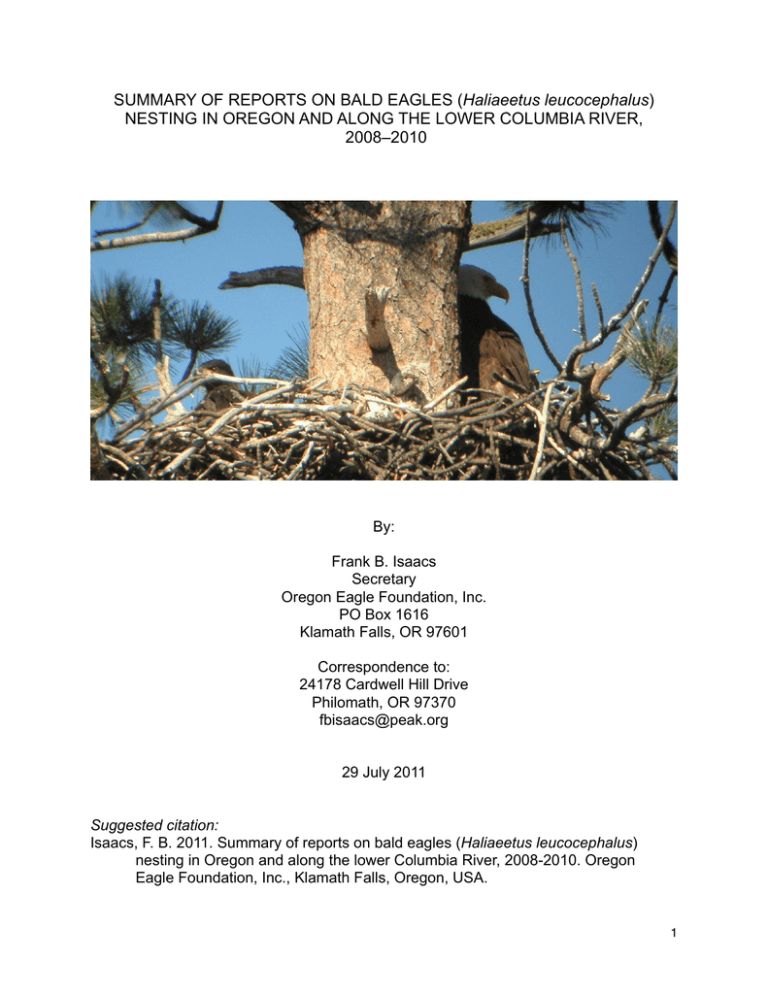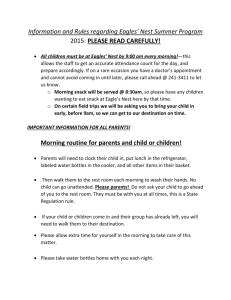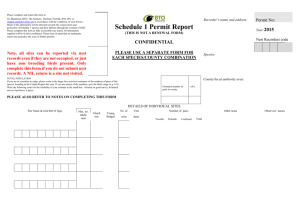Haliaeetus leucocephalus NESTING IN OREGON AND ALONG THE LOWER COLUMBIA RIVER, 2008–2010
advertisement

SUMMARY OF REPORTS ON BALD EAGLES (Haliaeetus leucocephalus) NESTING IN OREGON AND ALONG THE LOWER COLUMBIA RIVER, 2008–2010 By: Frank B. Isaacs Secretary Oregon Eagle Foundation, Inc. PO Box 1616 Klamath Falls, OR 97601 Correspondence to: 24178 Cardwell Hill Drive Philomath, OR 97370 fbisaacs@peak.org 29 July 2011 Suggested citation: Isaacs, F. B. 2011. Summary of reports on bald eagles (Haliaeetus leucocephalus) nesting in Oregon and along the lower Columbia River, 2008-2010. Oregon Eagle Foundation, Inc., Klamath Falls, Oregon, USA. 1 INTRODUCTION Nesting bald eagles (Haliaeetus leucocephalus) in Oregon and along the lower Columbia River were monitored annually from 1978–2007. During that time, the nesting population increased exponentially (7.3% per year average), distribution expanded, density of breeding areas increased in most areas, and nesting success, productivity, and brood size increased significantly (Isaacs and Anthony 2011). Statewide monitoring ended in 2007 when the bald eagle was removed from the federal list of threatened and endangered species (U.S. Fish and Wildlife Service 2011). However, the bald eagle was still categorized as threatened by the state of Oregon as of 26 July 2011 (Oregon Department of Fish and Wildlife 2011), nesting habitat in Oregon and Washington was still managed under special protection rules (Oregon State Archives 2010, Washington Department of Fish and Wildlife 2010), and protection of individuals and nests continued under the Bald and Golden Eagle Protection Act, Migratory Bird Treaty Act, and Lacey Act (U.S. Fish and Wildlife Service 2011). Even though formal statewide monitoring ended in 2007, volunteers and resource managers continued to monitor and submit reports through 2010. The purpose of this project was to summarize 2008–2010 reports, update the statewide list of nest tree locations, and evaluate the results of monitoring relative to the 1978–2007 effort. ACKNOWLEDGEMENTS Bureau of Land Management, U.S. Forest Service, and U.S. Fish and Wildlife Service funded the data summary and reporting phase of this project. Data archiving was donated by the author on behalf of Oregon Eagle Foundation, Inc. The bulk of the time and effort to make this project possible was the data collection and reporting that was donated by volunteers or funded internally by cooperating organizations. The value of those contributions was at least tens-of-thousands of dollars. Many people contributed to the project and everyone’s effort was appreciated. Several volunteers deserve special mention for their outstanding contributions: A. Ahlgrim and L. Swanson along the Molalla River; J. & S. Anderson in central Oregon; B. Anthony and C. Meslow along the Willamette River; C. Bruce in the Willamette Valley; M. Christian, J. Van Moorhem, M. Lundy, P. Buettner, and R. Opp in the Klamath Falls area; R. & D. Cornforth and J. Gerke at Camp Polk; B. Dingle and D. & J. Sim in the Eugene area; L. & D. Dorbuck at South Slough; E. Everett and J. & G. Power in the Waldport area; D. Firstbrook and P. Walczak at Nehalem; J. Fleischer in Linn County; C. Foster at Burlington; C. Hallett at Fort Williams Bend; J. Harper in the Rogue River Valley; E. Herron at Siltcoos Lake; C. Karlen in Polk County; K. & M. Kidwell at Banks; D. Manzer in the Tualatin Valley; N. McDonald at Lytle Creek; M. & J. McKinney at Goose Creek; M. Mefford on the central Oregon coast; L. & S. O’Neill and J. Ramey along the upper Deschutes River; B. Price, B. Dishaw, S. Johnston, and B. Papsteim along the Columbia River; H. & J. Sherlock in the Elkton area; G. Sausen and J. Hohmann in NE Oregon; L. Sharp at Ross Island; L. Steiner at Sand Lake; P. Sullivan at various locations; J. Walthers at Klamath Marsh; S. Whittey along the lower Columbia River; and B. & J. Woodhouse at Tillamook. My sincere apologies to any deserving volunteers that I missed. 2 Finally, special thanks to natural resource specialists from cooperating organizations that continued monitoring bald eagle nests after delisting, contributed hundreds of reports, and patiently responded to my questions. STUDY AREA & METHODS The study area consisted of the state of Oregon and the Washington side of the Columbia River. Methods consisted of observing bald eagle nests during the breeding season (mid February through July) annually from 2008–2010 and reporting those observations. Study area and methods were described in detail by Isaacs and Anthony (2011). For this project, reports were collected and archived in printed or digital format from 2008–2010 then summarized and analyzed during spring and early summer 2011. Data summary involved naming and numbering new breeding areas, numbering new nest trees and determining their locations, and determining nesting outcomes for breeding areas that were monitored. The terms “breeding area” and “nest site” were synonymous and referred to an area used for nesting by a single breeding pair of bald eagles. Breeding areas could have more than one nest tree. New breeding area and nest tree numbers were assigned sequentially as they were confirmed and cataloged in continuation of the system used through 2007 (Isaacs and Anthony 2011:24). Annual nesting outcomes were assigned based on observations and consisted of one of the following designations per year per breeding area: NS = NOT SURVEYED UNOC = UNOCCUPIED - Nest present, but no breeding-age eagles detected. UNOX = POSSIBLY UNOCCUPIED - Not enough information to be certain; outcome unknown; also used for: repaired nest but no eagles. OCXX = POSSIBLY OCCUPIED - Not enough information to be certain; outcome unknown; also used for: eagles but no usable nest. OCCX = OCCUPIED - Breeding-age eagle(s) observed but number of eagles not reported; outcome unknown. OC1X = OCCUPIED 1 - 1 breeding-age eagle and a nest; outcome unknown. OC2X = OCCUPIED 2 - 2 breeding-age eagles and a nest; outcome unknown. OCEX = OCCUPIED, EVIDENCE OF EGGS - Outcome unknown; also used for all sites where fresh eggs were collected. OCCF = OCCUPIED, FAILED - Breeding-age eagle(s) and a nest observed; no evidence of eggs. OC1F = OCCUPIED 1, FAILED - 1 breeding-age eagle and a nest observed; no evidence of eggs. OC2F = OCCUPIED 2, FAILED - 2 breeding-age eagles and a nest observed; no evidence of eggs. OCEF = OCCUPIED, EVIDENCE OF EGGS, FAILED - Evidence of eggs, but no young observed. 1d = SUCCESSFUL, 1 SMALL YOUNG - Nestling less than 5 weeks old. 2d = SUCCESSFUL, 2 SMALL YOUNG - One or both nestlings less than 5 weeks old. 3 3d = SUCCESSFUL, 3 SMALL YOUNG - At least one nestling less than 5 weeks old. 1 = SUCCESSFUL, 1 YOUNG - Nestling or fledgling 5 weeks old or older. 2 = SUCCESSFUL, 2 YOUNG - Nestlings or fledglings 5 weeks old or older. 3 = SUCCESSFUL, 3 YOUNG - Nestlings or fledglings 5 weeks old or older. If observations were unclear or inconclusive a conservative outcome was used. For example, when observers reported that a nest site was “unoccupied” after one visit, late in the nesting season, I used UNOX (possibly unoccupied, not enough information to be certain) because the observer could not be certain the site was not occupied early in the breeding season and that nesting failed prior to the observation. Outcomes were summarized by year to compare survey effort and quality and nesting success and productivity between years. Locations of new nest trees were mapped as accurately as possible and NAD27 coordinates were recorded for as many nest trees as possible. RESULTS & DISCUSSION Breeding Area & Nest Tree Locations Several thousand reports on nesting bald eagles in Oregon and along the lower Columbia River representing thousands of hours of effort were submitted by volunteers and resource managers during 2008–2010. Those reports contained records of 73 previously unreported breeding areas and 222 new nest trees and 1 nest on a power pole. Those additions to the lists of breeding areas and nest trees on the study area resulted in 739 bald eagle breeding areas and 1869 nest structures (1867 trees and 2 power structures) documented since 1971 (Table 1). Table 1. Bald eagle breeding areas and nest trees in Oregon and along the lower Columbia River, through 2007 and 2008–2010. Table 1. Locations 1971–2007 2008 Additions 2009 Additions 2010 Additions 1971–2010 Breeding Areas 666 16 34 23 739 Nest Trees & 2 Power Structures 1646 74 83 66 1869 4 Monitoring Effort Monitoring effort during 2008–2010 was extraordinary because there was no official statewide monitoring project. Continued monitoring was partly the result of “momentum” after 30 years of annual monitoring (Isaacs and Anthony 2011), and partly the continued need for organizations to comply with laws protecting nesting bald eagles. Effort and effectiveness declined after 2007. The percentage of breeding areas surveyed (effort) decreased from 96% for 1978–2007 to 67% in 2010 and the percentage of breeding areas with known outcome (effectiveness) decreased from 80% to 48% in the same period (Table 2). Both declines primarily were the result of reduced funding for bald eagle monitoring after the species was delisted. Another cause of the decline in effectiveness was inadequate monitoring and reporting resulting in unknown outcomes even though there was monitoring effort. Table 2. Monitoring effort for bald eagles nesting in Oregon and along the lower Columbia River, 1978–2007, 2008, 2009, and 2010. Table 2. Monitoring Effort 1978–2007 2008 2009 2010 Breeding Areas Listed 9,679 682 716 739 Breeding Areas Surveyed 9,282 96% 554 81% 573 80% 498 67% Breeding Areas With Known Outcome 7,697 80% 403 59% 419 59% 358 48% 5 Monitoring Results Monitoring results from breeding areas with known outcome differed between 1978–2007 and 2008–2010 (Table 3). The differences probably were the result of monitoring technique and reporting rather than changed bald eagle reproductive parameters. Nesting success was higher during 2008–2010 and probably was the result of nesting failures being categorized as unknown outcome rather than failures. That is likely to occur with reduced monitoring effort because documenting failed nesting attempts often takes more than two properly-timed observations at breeding areas. Young per occupied breeding area was also higher during 2008–2010, probably for the same reason. Young per successful nesting attempt (brood size) was smaller for 2008– 2010 and probably was the result of observers missing second eaglets in nests. Eaglets laying on the nest surface are often out of view to observers on the ground and eaglets might not move into view for an hour or more, or until an adult arrives at the nest. None of these differences were biologically significant and the overall reproductive performance was similar to that documented from 1978–2007, and adequate to support a stable or increasing population. Table 3. Nesting success and productivity of bald eagles nesting in Oregon and along the lower Columbia River, 1978–2007, 2008, 2009, and 2010. Table 3. Outcomes 1978–2007 2008 2009 2010 Breeding Areas With Known Outcome 7,697 403 419 358 Nesting Success 62% 68% 70% 70% Young/Occupied Breeding Area 0.97 1.03 1.08 1.04 Young/ Successful Breeding Attempt 1.57 1.52 1.54 1.50 6 Distribution Of Breeding Areas Distribution of breeding areas discovered during 2008–2010 was similar to distribution through 2007, and the first breeding area for the Owyhee watershed (Bully Creek Reservoir) was reported in 2009. Overall, annual population growth rate (r = 0.35 or 3.5%) for 2008–2010 was approximately half of the 7.3% reported for 1978–2007 (Isaacs and Anthony 2011). Slower growth from 2008–2010 may be explained by reduced monitoring effort and effectiveness described above. In addition, there was less effort to search likely habitat for new breeding areas during 2008–2010. Population growth by watershed (Table 4) continued a trend reported in 2007; population growth was higher at low elevations west of the Cascades (Columbia, Pacific, and Willamette watersheds) than at high elevations east of the mountains (Deschutes and Klamath watersheds). Table 4. Distribution of breeding areas among watersheds and population growth rate (r) by watershed in Oregon and along the lower Columbia River, 2007 and 2010. Instantaneous rate of growth = r = [ln(Nt/No)]/t, where Nt was the population at time t (2010), No was the initial (2007) population size, and t was the number of time periods (3). Table 4. Watersheds 2007 2008–2010 Additions 2010 r 2007–2010 Columbia 177 23 200 0.041 Deschutes 84 8 92 0.030 Harney 3 2 5 0.170 Klamath 156 5 161 0.011 Northeast 16 1 17 0.020 Owyhee 0 1 1 –– Pacific 111 15 126 0.042 Rogue 32 0 32 0.000 Snake 3 0 3 0.000 Willamette 84 18 102 0.065 666 73 739 0.035 Study Area Total 7 CONCLUSIONS & RECOMMENDATIONS The population of nesting bald eagles in Oregon and along the lower Columbia River continued to increase during 2008–2010 resulting in a minimum population estimate of 636 nesting pairs (739 breeding areas X 0.861 occupied; occupation rate from Isaacs and Anthony 2011:Table 1). The minimum population estimate for the state of Oregon was 570 (636 nesting pairs X 0.897 in Oregon; Oregon proportion from Isaacs and Anthony 2011:4). In addition, productivity of breeding pairs was near 1.00 young per occupied breeding area and evidently adequate to support a stable or increasing population. The 2008–2010 population increase was represented by nest trees discovered annually (Table 1). These “new” nest trees (n = 222) were found at both known and previously unknown breeding areas. Documenting and cataloging locations of nest trees as they are discovered and providing information on locations of all known nest trees to resource managers in a timely manner may be the single most important conservation measure for protecting nesting bald eagles in Oregon. Those locations provide “red flags” for land and wildlife managers to use for protecting habitat and provide wildlife managers and researchers with starting points for future monitoring and research. Monitoring effort and effectiveness declined from 2007 to 2010. However, nesting outcome was determined for 55% of breeding areas during that time and represented a substantial effort on the part of volunteers and resource managers. Monitoring effectiveness could be improved if observers followed protocol for survey timing (at least two properly-timed surveys), determined nesting status during surveys (observe eagles and/or nests until certain of nesting status), and reported details needed for evaluating nest status and outcome (Appendix 1). LITERATURE CITED Isaacs, F. B., and R. G. Anthony. 2011. Bald eagles (Haliaeetus leucocephalus) nesting in Oregon and along the lower Columbia River, 1978–2007. Final Report, 18 March 2011. Oregon Cooperative Fish and Wildlife Research Unit, Department of Fisheries and Wildlife, Oregon State University, Corvallis, Oregon, USA. Available on-line at: http://fw.oregonstate.edu/pdfs/BaldEagle.pdf Oregon Department of Fish and WIldlife. 2011. Wildlife Diversity (Nongame) Program. Available on-line at: www.dfw.state.or.us/wildlife/diversity/species/ threatened_endangered_candidate_list.asp 26 July 2011. Oregon State Archives. 2010. Department of Forestry; Division 665; Specified resource site protection rules. Available on-line at: http://arcweb.sos.state.or.us/rules/ OARS_600/OAR_629/629_665.html 21 September 2010. U.S. Fish and Wildlife Service. 2011. Bald eagle. Available on-line at: www.fws.gov/ midwest/eagle/ 26 July 2011. 8 Washington Department of Fish and Wildlife. 2010. Bald eagle management & protection in Washington state. Available online at: http://wdfw.wa.gov/ conservation/bald_eagle/ 21 September 2010. 9 Appendix 1. Primary items to report when monitoring bald eagle breeding areas are listed below. This information is needed to evaluate nesting status and determine outcome. Field notes could include age class (adult or subadult) and behavior of each bald eagle observed; number of nestlings and plumage class (Appendix 2) for each nestling; condition of nest(s) and nest tree(s); any other pertinent observations, e.g. new nest material, nest building, weather, prey, other raptors, unusual human activities, etc. Use one form per breeding area per year and attach additional pages if needed. Some people like to report on forms and some people prefer to write prose. Either works as long as the primary items are included in the reports. Do not use codes for nesting status. Photos or sketches can be useful, especially for documenting unusual events or relocating difficult to find nests. Year: Breeding Area Name and/or Number: Observer Name(s) and Contact Information: Observation Point Description or GPS Datum and Coordinates: Maximum Number of Adult Bald Eagles Observed Simultaneously: Number of the Nest Tree with Evidence of Eggs (adult in incubating or brooding posture, adult feeding unseen nestlings, nestlings): If a New Nest Tree is discovered, record GPS Datum and Coordinates of the tree (or attach a detailed map showing the nest tree location): Number and Age or Plumage Class of Young: Date, Start and End Times, and Field Notes for Each Day Observed: 10 Appendix 2. 11





